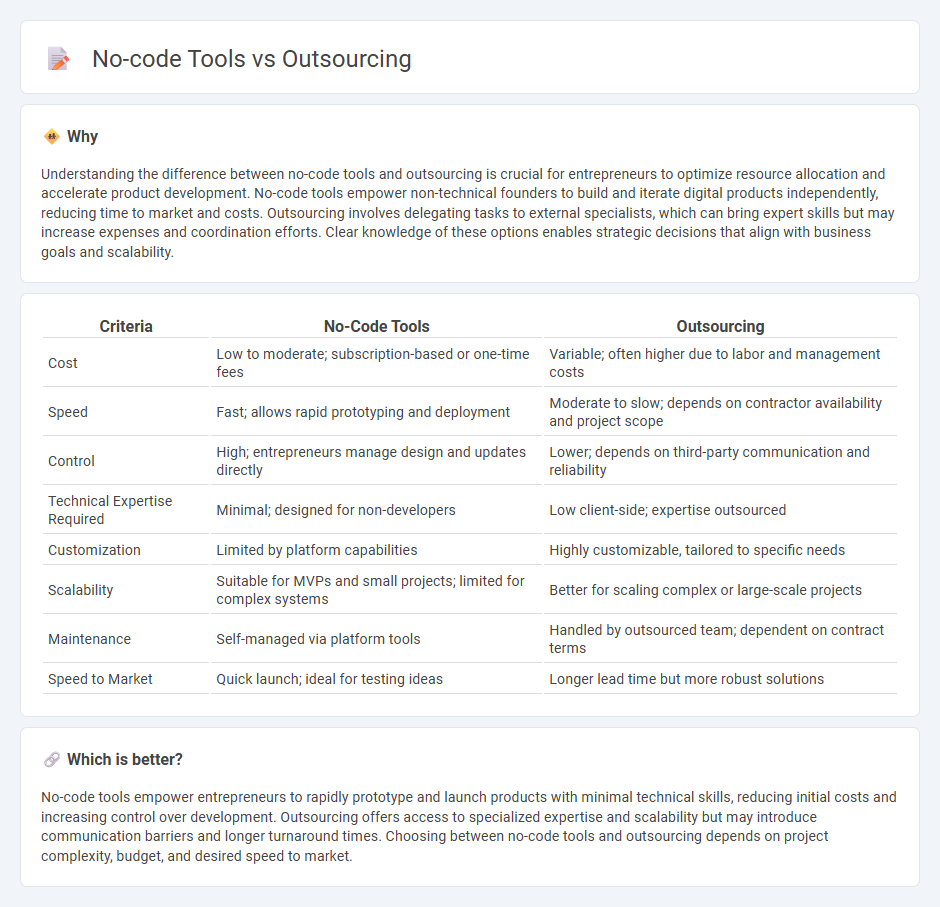
No-code tools empower entrepreneurs to build and launch projects rapidly without extensive programming skills, reducing upfront costs and increasing agility. Outsourcing offers access to specialized expertise and scalable resources, allowing startups to focus on core business functions while delegating technical development. Explore these strategies to determine which approach best aligns with your entrepreneurial goals and growth plans.
Why it is important
Understanding the difference between no-code tools and outsourcing is crucial for entrepreneurs to optimize resource allocation and accelerate product development. No-code tools empower non-technical founders to build and iterate digital products independently, reducing time to market and costs. Outsourcing involves delegating tasks to external specialists, which can bring expert skills but may increase expenses and coordination efforts. Clear knowledge of these options enables strategic decisions that align with business goals and scalability.
Comparison Table
| Criteria | No-Code Tools | Outsourcing |
|---|---|---|
| Cost | Low to moderate; subscription-based or one-time fees | Variable; often higher due to labor and management costs |
| Speed | Fast; allows rapid prototyping and deployment | Moderate to slow; depends on contractor availability and project scope |
| Control | High; entrepreneurs manage design and updates directly | Lower; depends on third-party communication and reliability |
| Technical Expertise Required | Minimal; designed for non-developers | Low client-side; expertise outsourced |
| Customization | Limited by platform capabilities | Highly customizable, tailored to specific needs |
| Scalability | Suitable for MVPs and small projects; limited for complex systems | Better for scaling complex or large-scale projects |
| Maintenance | Self-managed via platform tools | Handled by outsourced team; dependent on contract terms |
| Speed to Market | Quick launch; ideal for testing ideas | Longer lead time but more robust solutions |
Which is better?
No-code tools empower entrepreneurs to rapidly prototype and launch products with minimal technical skills, reducing initial costs and increasing control over development. Outsourcing offers access to specialized expertise and scalability but may introduce communication barriers and longer turnaround times. Choosing between no-code tools and outsourcing depends on project complexity, budget, and desired speed to market.
Connection
No-code tools accelerate entrepreneurship by enabling founders to rapidly build and test products without deep technical expertise, reducing time-to-market and development costs. Outsourcing complements this by allowing startups to delegate specialized tasks like design, marketing, or complex backend development to external experts, optimizing resource allocation. Together, no-code platforms and outsourcing empower entrepreneurs to scale efficiently while focusing on core business growth and innovation.
Key Terms
Cost-efficiency
Outsourcing development projects typically involves higher upfront costs and variable ongoing expenses depending on the provider's location and expertise, whereas no-code tools significantly reduce costs by enabling in-house teams to rapidly build and iterate applications without specialized programming skills. No-code platforms often include subscription fees and potential scalability limitations but offer faster deployment and lower maintenance overhead, optimizing cost-efficiency for small to medium-sized projects. Explore how strategic use of no-code tools compares to outsourcing in your business context to maximize budget and productivity.
Scalability
Outsourcing development offers scalable solutions by leveraging specialized expertise and flexible resources, enabling businesses to handle growing project demands efficiently. No-code tools provide scalability through rapid iteration and easy customization, allowing non-technical users to adapt applications quickly without extensive coding. Explore the advantages and limitations of both approaches to determine the best scalability strategy for your business.
Customization
Outsourcing software development provides highly specialized customization tailored to specific business needs, leveraging expert skills and extensive resources for complex projects. No-code tools offer rapid development with predefined templates and modular components, enabling users to quickly build applications but often with limited flexibility for unique or advanced features. Explore how each option balances customization and efficiency to determine the best fit for your project requirements.
Source and External Links
What is Outsourcing? Definition, Advantages, and Examples - Outsourcing is a business practice where a company contracts with a third-party service provider to perform specific tasks or services, allowing the company to reduce costs, focus on core activities, and gain specialized expertise.
What is Outsourcing and How Does it Work? - TechTarget - Outsourcing involves hiring an external provider to perform tasks or operations, either onsite or remotely, and requires managing the partnership effectively for success, often covering IT, customer service, manufacturing, and more.
What Is Outsourcing? (Including Types and Advantages) | Indeed.com - Outsourcing is hiring outside contractors or companies to perform business functions such as HR, accounting, customer support, or production to reduce costs, improve efficiency, and access skills not available in-house, with types including onshore, offshore, nearshore, and onsite sourcing.
 dowidth.com
dowidth.com